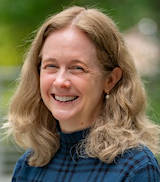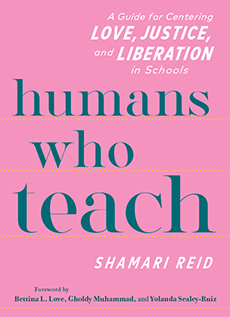Centering Love, Justice & Liberation in Schools
Humans Who Teach: A Guide for Centering Love, Justice, and Liberation in Schools
By Shamari Reid
(Heinemann, 2024 – Learn more)
Reviewed by Sarah Cooper

Yeah, my mom was a teacher – an English teacher for whom weekends were a chance to catch up on grading, lesson planning, and sleep. She was a role model in so many ways, but her less healthy workaholic tendencies are ones I still see in myself today (as I write this review on a Sunday night).
Shamari Reid, an assistant professor of justice and belonging in education at NYU, acknowledges this creative tension of passionate teachers beautifully in Humans Who Teach, his first book.
With quotations from Reid’s literary inspiration Toni Morrison, stories from growing up and then teaching as “a Black LGBTQ+ human,” and imaginings of how we can honor ourselves and our students, his book will call to you with its courage.
It’s no wonder that the Foreword was written by Bettina Love, Gholdy Muhammad and Yolanda Sealey Ruiz, since Humans Who Teach epitomizes a personal approach that spans liberationist, culturally and historically responsive, racial literacy, joy-infused, and other love-centered pedagogies.
Starting with Intention

As an adult, he asserts that “I now understand love as that which moves us to nurture the physical, emotional, and spiritual growth of others and ourselves.”
Like Oprah, Reid begins everything with intentions. In a list of a dozen at the beginning of the book, he wants, among other things,
- “to make it clear that there is action necessary to take up the ideas I share throughout this book and that this action is possible”
- “to push against the voices that make you feel like you must neglect your humanity to be a successful human who teaches”
- “to show you that practicing self-care alone will not result in the world you, your students, and their communities deserve.”
The ideas that self-care is insufficient, that teachers are better humans and teachers if they pay attention to their own needs, and that simply thinking about change is not enough permeate the book, as illuminated by the table of contents:
Chapter 1: The World and Us: Humans Who Are Socialized
A place for us to explore our complicated humanity together and to get to know the cycle of our collective socialization as humans
Chapter 2: Humans Who Have Self-Regard
A guide for unlearning negative behavior that can lead to dehydrating ourselves as humans who teach
Chapter 3: Humans Who Love
An exploration of our human ability to practice radical love
Chapter 4: Humans Who Teach with Love
Exercises, tools, and guidance for drawing on love to teach for social justice
Chapter 5: Humans Who Fear
A framework to help us honor our commitments to justice and equity and education even in the presence of fear
Recognizing Unrealistic Expectations – Society’s and Our Own
As he started teaching, Reid felt that he might act as a savior for his students: “I was socialized to believe that my pedagogy was going to rescue my Black students and students experiencing poverty from racism, classism comment and other social ills. I was no longer human; I was a teacher.” This superhero standard led him to become extremely sick with something like the flu toward the end of his first year.
His doctor’s verdict was exhaustion of all kinds, because “I was at once trying to be a savior to my students and trying to make sure no one in my school could question my ability as a teacher and value as a human,” an impossible lift.
Reid goes on to state the obvious – but an obvious that many of us go right on ignoring, quite deliberately, day by day: “Too many teachers have an unhealthy work-life balance of which we are unaware or that we have normalized as part of our jobs.” Do we feed ourselves figuratively and literally? Where did we leave our water bottle? Are we taking moments to breathe? For too many of us, the answer is too often no.
Humans Who Teach tells many stories to lift the veil on the weights of expectation placed on teachers, by themselves and society. This book offers appealing pages where we can journal on where our time goes and what we need to function well, day to day. And it makes us think about exactly how we care for ourselves physically, emotionally, and even spiritually, to “cultivate more joy and love in our lives.”
Reid’s list of what nourishes his spirit will inspire you to make your own: “It will look different for each person, but I get great joy from engaging in conversations with others, listening to Mariah Carey, talking with my nieces and nephews about their dreams, cooking, eating, playing board games with loved ones, reading Toni Morrison, thinking about the wonderful moments I had with my sister during childhood, talking about singing with my cousin, traveling, and teaching. The spirit makes us human and able to cultivate relationships with ourselves and the world around us.”
So what makes us able to “cultivate relationships” with students and colleagues, family and friends, without extinguishing our own flame of energy? How can we meet each person in relationship each day? Even reading his list makes me want to knock off work a little earlier, soak in a few more minutes of sunshine on an after-school walk, pull out a book of poetry or listen to an Oprah podcast. (Coincidentally, her latest Super Soul Special while I write this is on “finding your spiritual path”).
Jolting Ourselves into Action to Help Ourselves and Our Students
In the last half of the book, Reid suggests specific tools to “center love in our work as humans who teach” and then offers ways to jump-start ourselves if action seems difficult.
Though a frame called QuestionWork, accompanied by a colorful, circular diagram, he asks us to consider (without making more work for ourselves): “As a human who teaches, in what ways does my approach to teaching…”
- Promote the physical, emotional, and spiritual growth of my students?
- Respond to the actual (and not assumed) circumstances and challenges my students are navigating?
- Privilege the lives of students over the livelihoods of others?
- Interrupt the things, ideas, and people that threaten the humanity of my students?
- Resist the status quo with regard to our collective socialization?
By knowing our students deeply, we can backward design to reflect their lives and experiences, all the while remembering that “[t]eaching is political. It is human work done within the hearts and minds of young people informed by our hearts and minds as humans who teach.”
And does this responsibility feel like a lot? It is a lot and may require sacrifice, Reid says. So, where does he begin when he is “confronted with the decision to make big moves in my life that honor my commitments to myself and working toward the world we all deserve?” He starts by journaling, visioning, breaking a goal into doable steps, and breathing, because “It is not usually a great idea to show up to the work we want to do tired.”
As I was writing this review, I was tired. I wondered if I should put it off for a few more days. I saw the irony of pushing my mind and body while reviewing a book about being more human as a teacher.
At the same time, I knew that the writing would help me process my own commitments to myself and my students, leading to a renewed sense of intention and, yes, love when I see them again this week.
This slim, colorful book about love is only 118 pages, with a bold pink cover. That’s no accident – it echoes the red cover of bell hooks’ All About Love: New Visions. If you are tired, Humans Who Teach will nourish you in your most basic intentions.
Sarah J. Cooper teaches eighth-grade U.S. History and is Associate Head of School at Flintridge Prep in La Canada, California, where she has also taught English Language Arts. Sarah is the author of Making History Mine (Stenhouse, 2009) and Creating Citizens: Teaching Civics and Current Events in the History Classroom (Routledge, 2017). She presents at conferences and writes for a variety of educational sites. You can find all of Sarah’s writing at sarahjcooper.com.

































